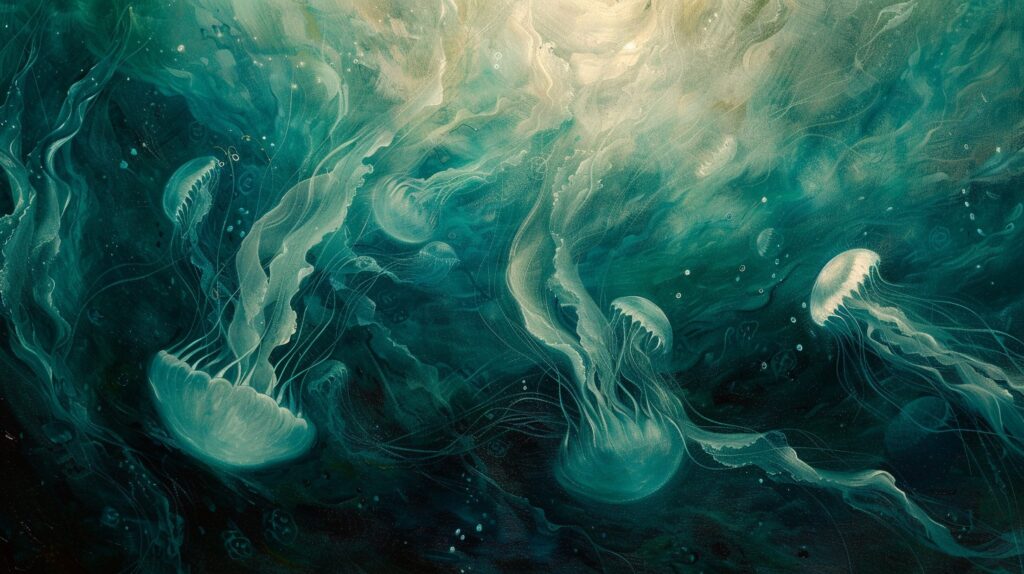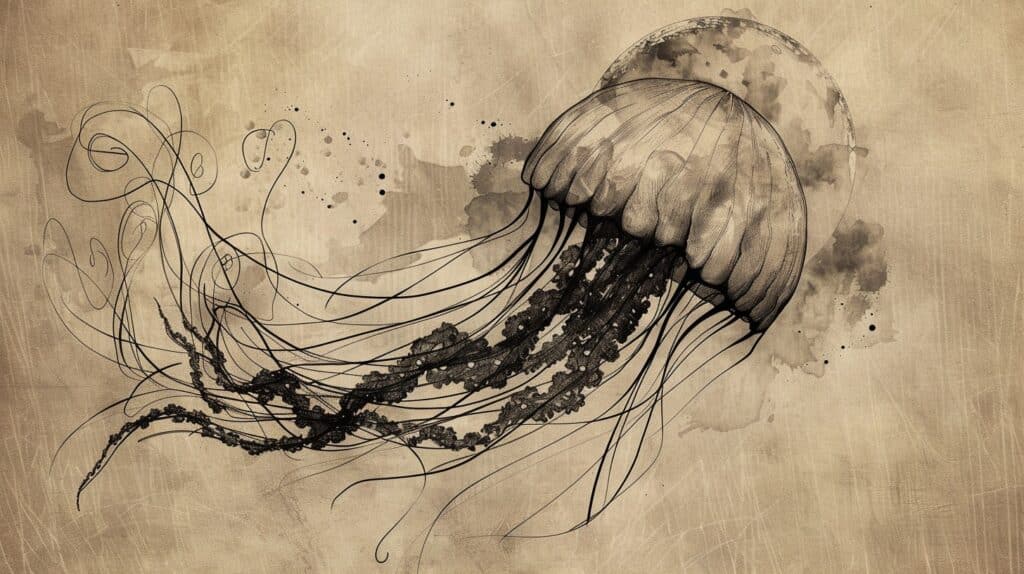It floated past me like a ghost — silent, soft, and strangely magnificent.
At that moment, I didn’t just see a jellyfish.
I felt something.
It wasn’t just a sea creature drifting in the ocean’s current. It was a message. An omen. A metaphor from the universe.
This is the strange, mesmerizing magic of jellyfish symbolism. And the deeper you look, the more it reveals about your own journey — emotionally, spiritually, and symbolically.
So, what does the jellyfish truly mean?
Let’s go deeper.
The Spiritual Meaning of Jellyfish
On the surface, jellyfish appear simple. But beneath their transparent bodies lies an ancient intelligence — one that doesn’t shout or fight. One that flows.
In the spiritual realm, jellyfish are symbols of intuition, emotional depth, divine flow, and vulnerability. They move with the tides, never fighting the current, but always moving. Always trusting.
Spiritually, the jellyfish invites you to stop clenching your fists. To loosen your grip on control. To trust that the currents of your life are carrying you exactly where you’re meant to go.
When the jellyfish shows up in your life — whether in a dream, meditation, art, or even an unexpected encounter at the beach — it often brings the following messages:
- Surrender to the moment, stop resisting.
- Embrace your sensitivity; it’s not a weakness, it’s a compass.
- Let your inner light shine, even if the world can’t always see it.
- Allow the tides of your emotions to move through you without judgment.
There’s a soft power in the jellyfish’s presence. A quiet strength. It doesn’t need a hard shell or loud roar. It survives — beautifully — just as it is.
Jellyfish as a Spirit Animal
Some spirit animals come in loud and bold, like lions or hawks. The jellyfish isn’t one of them.
If the jellyfish has emerged as your spirit animal, it might be because you’re learning how to move through life differently. Less force. More flow. Less fear. More feeling.
The jellyfish spirit animal brings lessons that are almost always emotional. You might be someone who:
- Feels energy and emotion deeply, sometimes too deeply.
- Needs to stop overthinking and learn to trust gut instincts.
- Struggles to release control but longs for inner peace.
- Has a soft exterior, but a resilient soul.
- Finds strength in vulnerability and openness.
The jellyfish spirit asks you to be who you are without apology. Sensitive. Transparent. Fluid. It shows you that softness doesn’t mean weakness. It means honesty. It means healing.
Jellyfish energy is about floating into alignment with your inner truth, even when it doesn’t make logical sense. Especially when it doesn’t.

Dreaming of Jellyfish: What Does It Mean?
When jellyfish start appearing in your dreams, your subconscious is trying to tell you something. And it’s usually emotional.
Dreams featuring jellyfish often point to issues you’ve buried deep — feelings you’re afraid to confront, emotional patterns you need to understand, or a message that it’s time to surrender and stop swimming against your own instincts.
Here’s what some common jellyfish dreams might mean:
- Stung by a jellyfish: You’re dealing with emotional pain or betrayal that hasn’t been addressed. Something or someone is hurting you beneath the surface.
- Watching jellyfish swim peacefully: You’re seeking peace and emotional clarity. This dream is a sign of alignment or spiritual reassurance.
- Trapped or surrounded by jellyfish: You’re feeling overwhelmed by emotions or the emotional energy of others.
- Catching a jellyfish: You may be trying to control something that’s meant to be free — a person, an emotion, or even your own healing process.
Dream jellyfish often reflect the parts of us that are soft, sensitive, or scared — the ones we try to hide. But they also bring grace, healing, and permission to feel without fear.
Jellyfish Symbolism in Different Cultures
Across the world, jellyfish carry different meanings, yet one thing remains constant: they are seen as beings of mystery, emotion, and power hidden behind beauty.
In Japanese and Chinese cultures, jellyfish are sometimes viewed as spirit messengers — connected to water, femininity, and the power of the moon. Their graceful movement is associated with the flow of energy or chi, and their presence in art often symbolizes emotional wisdom.
In Hawaiian mythology, jellyfish are sometimes linked to divine retribution or oceanic spirits. Though feared, they’re respected as a reminder not to mess with the natural order.
Many indigenous coastal cultures view jellyfish as symbols of ancestral energy, ocean memory, and even time itself — floating archives of what the Earth remembers.
In Western perspectives, jellyfish often appear in art and poetry as metaphors for delicacy, mystery, and alien-like beauty. They symbolize something beautiful that doesn’t need to shout to be powerful.
In all cultures, jellyfish share a common thread: the ability to move with life, not against it. To float through chaos with grace. To survive, not by force, but by presence.

Jellyfish Tattoos: What Are They Really Saying?
A jellyfish tattoo is more than just a design — it’s a declaration of a personal truth. People who choose to ink this creature onto their skin often resonate with what it represents: quiet strength, emotional clarity, and the courage to be vulnerable.
Here are some of the most common meanings behind jellyfish tattoos:
- Emotional depth: A reminder to honor and explore one’s inner world.
- Resilience through softness: Surviving without armor.
- Mystery and sensuality: Representing the unknown, the unseen, and the unspoken.
- Flow and surrender: A commitment to stop forcing life and start flowing with it.
- Spiritual evolution: Reflecting growth, healing, and ascension through emotional awareness.
Many jellyfish tattoos are stylized with long, trailing tentacles — as if the wearer is embracing their own energy field, their aura, their reach into the emotional ocean of life.
The Jellyfish in Art, Literature, and Pop Culture
From poetry to painting to science fiction, the jellyfish has emerged as a muse for creatives across centuries.
Writers use jellyfish to symbolize feelings that are hard to define: love, longing, sadness, beauty, fragility. Artists are drawn to its form — ethereal, luminescent, and unlike anything else.
In literature, jellyfish often represent feelings that are hard to touch or describe. They become metaphors for childhood memories, faded love, or moments of haunting beauty. Sylvia Plath once described them as “candles” in the sea — a perfect visual for something so soft yet burning with presence.
In pop culture, they’ve been imagined as alien beings, dangerous beauties, or oceanic prophets — all depending on what side of them the artist wants to show.
And maybe that’s the most powerful thing about jellyfish.
They’re mirrors.
You see in them what’s in you — beauty, danger, softness, survival, feeling, floating, letting go.
What Jellyfish Symbolism Reminds Us
There is no creature more misunderstood than the jellyfish.
It has no bones, no brain, and no blood. And yet, it survives. It thrives. It has outlived dinosaurs.
It teaches us the strength of surrender.
It shows us that vulnerability is a form of wisdom.
It reminds us to listen to our own tides.
You don’t have to be tough to be powerful.
You don’t have to force things to make them happen.
You don’t have to hide your softness to be taken seriously.
Sometimes, the bravest thing you can do is feel deeply and move gently.
Like the jellyfish.
Working With Jellyfish Energy: How to Use This Symbol in Real Life
Symbolism doesn’t matter if it stays abstract. The beauty of jellyfish symbolism is that you can actually live it. It’s not just something you read about — it’s something you can embody.
Here’s how to bring jellyfish energy into your everyday life, especially if you’re in a season of change, emotional overwhelm, or spiritual growth.
Let Go of Control
This is the jellyfish’s primary lesson.
In a world that constantly tells you to hustle, push, fight, and force, the jellyfish reminds you of an ancient truth: Not everything is yours to manage. Sometimes, letting go is the power move.
Ask yourself:
- Where am I swimming upstream in my life?
- What am I trying to control that might actually work better if I let go?
- Can I trust the current, even if I don’t know where it’s taking me?
Try this: Take a day to not plan everything. Let your instincts guide you — even if it’s just where to walk, what to eat, who to reach out to. Observe how different that feels.
Honor Your Sensitivity
Sensitivity has gotten a bad rap. You’ve probably heard: “Don’t be so sensitive,” or “Toughen up.” But jellyfish energy says the opposite. It says sensitivity is a gift — the ability to feel, to sense, to connect deeply.
Ways to honor your sensitivity:
- Stop apologizing for your emotions.
- Pay attention to what environments drain or nourish you.
- Create energetic boundaries where needed — not walls, but filters.
- Practice emotional hygiene the way you practice physical hygiene.
You are allowed to feel everything. That’s not a flaw. That’s your compass.
Meditate With Jellyfish Energy
If you’re drawn to this symbol, try including it in your spiritual practice. Meditating on jellyfish energy can bring clarity, peace, and surprising insight. This works especially well if you’re dealing with emotional blockages, anxiety, or confusion about your life direction.
Close your eyes and visualize yourself floating in calm, warm water. See yourself as a jellyfish — soft, glowing, at peace. With every breath, let go of something heavy. Let the current carry it away. Just float.
You’ll be surprised how this kind of imagery can soothe and reset your nervous system.
Common Questions About Jellyfish Symbolism (FAQs)
These questions often show up in Google’s People Also Ask section — and more importantly, they come from the heart of people looking for meaning.
Let’s answer them, not just for SEO, but with soul.
What does seeing a jellyfish mean?
Seeing a jellyfish — especially unexpectedly — is usually a sign to slow down and reflect. It may mean that you are entering a season where your emotions, intuition, or sensitivity need attention.
It could also be a reminder to surrender instead of resist, to let yourself be guided instead of always steering.
Is a jellyfish a good omen?
That depends on how you define “good.”
In spiritual symbolism, jellyfish are neither good nor bad — they’re true. They reflect what’s already happening in your life and offer wisdom about how to approach it.
If you’re going through something painful or uncertain, a jellyfish might not fix it — but it may show you how to move through it without getting stuck or overwhelmed.
In many traditions, jellyfish are seen as omens of transformation, spiritual evolution, and emotional clarity.
What if I dream about being stung by a jellyfish?
Being stung in a dream usually points to unresolved emotional wounds. Someone in your waking life may be triggering old pain, or you might be denying how something truly affected you.
The sting forces you to feel something — not to punish you, but to bring it into awareness so it can finally heal.
Don’t fear the sting. Ask what it’s trying to show you.
What chakra does the jellyfish relate to?
Jellyfish are closely connected to the sacral chakra — the energy center located just below the navel, associated with emotion, creativity, and fluidity.
A balanced sacral chakra allows you to move through life with grace and joy. When this chakra is blocked, you may feel stuck, creatively dry, or emotionally numb.
Jellyfish energy helps unblock this area by encouraging expression, sensation, and flow.
Emotional Archetypes of the Jellyfish
In deeper psychological and symbolic work, jellyfish represent certain emotional archetypes that we all carry within us — some consciously, others in the shadows.
Here are a few key archetypes tied to jellyfish:
The Empath
This is the part of you that feels everything. You’re highly attuned to people, environments, and energy. You might cry easily, get drained in crowds, or sense things others don’t pick up on.
The jellyfish reminds the Empath to protect their energy without shutting down their heart.
The Mystic
This is your intuitive, spiritual, and soulful side — the one that dreams, meditates, and communes with something greater.
The jellyfish mirrors the Mystic’s trust in the unseen and willingness to follow feeling over logic.
The Healer
This part of you absorbs pain, often to transmute it into compassion. You’ve likely been through hardship and come out the other side softer, not harder.
The jellyfish honors the Healer’s ability to turn emotional wounds into wisdom.
Jellyfish Energy in Relationships
Let’s not forget the relational symbolism.
How you love and connect to others often mirrors how you relate to your own emotional body — and jellyfish energy shows us a whole new way of being in relationships.
Rather than chasing love, it floats with love.
Rather than clinging, it allows.
Jellyfish relationships are emotionally aware, deeply attuned, and honest. There’s no room for pretending. There’s no facade. Just rawness, beauty, transparency.
If you’re navigating romantic dynamics right now — especially those that feel push-pull — jellyfish symbolism might be urging you to step back and ask:
- Am I forcing something that’s meant to flow?
- Am I dimming my sensitivity to be more “acceptable”?
- Is there room for softness in this love?
When you lead with jellyfish energy, you show up as your real self — not your performance.
Final Symbolic Takeaways: What the Jellyfish Teaches the Soul
By now, it’s probably clear that the jellyfish isn’t just some aesthetic sea creature. It’s a living lesson. A floating mirror. A teacher made of water and light.
Here’s what it ultimately reminds us of:
- Vulnerability is powerful.
- Flow is wiser than force.
- Transparency heals what hiding never could.
- Emotional depth is a sacred gift, not a flaw.
- You don’t have to fight to be worthy of your space in this world.
The jellyfish has survived on Earth for over 500 million years. No bones. No blood. No brain. Just feeling. Just flowing. Just being.
So maybe — just maybe — it’s figured out something we’re all still trying to learn.

